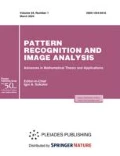Abstract
The nonnegative matrix factorization is a widely used, flexible matrix decomposition, finding applications in biology, image and signal processing and information retrieval, among other areas. Here we present a related matrix factorization. A multi-objective optimization problem finds conical combinations of templates that approximate a given data matrix. The templates are chosen so that as far as possible only the initial data set can be represented this way. However, the templates are not required to be nonnegative nor convex combinations of the original data.

Similar content being viewed by others
REFERENCES
D. D. Lee and H. S. Seung, “Learning the parts of objects by non-negative matrix factorization,” Nature 401 (6755), 788–791 (1999).
C. Ding, X. He, and H. D. Simon, “On the equivalence of nonnegative matrix factorization and spectral clustering,” in SIAM International Conference on Data Mining (2005).
J.-P. Brunet et al., “Metagenes and molecular pattern discovery using matrix factorization,” Proc. Natl. Acad. Sci. U. S. A. 101 (12), 4164–4169 (2004).
C. Ding, T. Li, and W. Peng, “On the equivalence between non-negative matrix factorization and probabilistic latent semantic indexing,” Comput. Stat. Data Anal. 52 (8), 3913–3927 (2008).
Y. Zhang and Y. Wang, “Nonnegative matrix factorization: A comprehensive review,” IEEE Trans. Knowl. Data Eng. 25 (6), 1336–1353 (2013).
C. H. Q. Ding, T. Li, and M. I. Jordan, “Convex and semi-nonnegative matrix factorizations,” IEEE Trans. Pattern Anal. Mach. Intell. 32 (1), 45–55 (2010).
A. Cutler and L. Breiman, “Archetypal analysis,” Technometrics 36 (4), 338–347 (1994).
A. Damle and Y. Sun, “A geometric approach to archetypal analysis and nonnegative matrix factorization,” Technometrics 59 (3), 361–370 (2016).
H. Javadi and A. Montanari, “Nonnegative matrix factorization via archetypal analysis,” J. Am. Stat. Assoc. 115 (530), 896–907 (2020).
T. H. Chan et al., “A convex analysis-based minimum-volume enclosing simplex algorithm for hyperspectral unmixing,” IEEE Trans. Signal Process. 57 (11), 4418–4432 (2009).
X. Fu et al., “Robust volume minimization-based matrix factorization for remote sensing and document clustering,” IEEE Trans. Signal Process. 64 (23), 6254–6268 (2016).
C. H. Lin et al., “Identifiability of the simplex volume minimization criterion for blind hyperspectral unmixing: The no-pure-pixel case,” IEEE Trans. Geosci. Remote Sens. 53 (10), 5530–5546 (2015).
L. Miao and H. Qi, “Endmember extraction from highly mixed data using minimum volume constrained nonnegative matrix factorization,” IEEE Trans. Geosci. Remote Sens. 45 (3), 765–777 (2007).
G. Zhou et al., “Minimum-volume-constrained nonnegative matrix factorization: Enhanced ability of learning parts,” IEEE Trans. Neural Networks 22 (10), 1626–1637 (2011).
D. Lee and H. Seung, “Algorithms for non-negative matrix factorization,” in Advances in Neural Information Processing Systems 13—Proceedings of the 2000 Conference (NIPS 2000) (2001), pp. 556–562.
K. A. Krakowski and J. H. Manton, “On the computation of the Karcher mean on spheres and special orthogonal groups,” in Proceedings of the Workshop on Robotics and Mathematics (2007).
D. W. Dreisigmeyer, Equality Constraints, Riemannian Manifolds and Direct Search Methods (2006). http://www.optimization-online.org/DB_FILE/2007/ 08/1743.pdf
A. Edelman, T. A. Arias, and S. T. Smith, “The geometry of algorithms with orthogonality constraints,” SIAM J. Matrix Anal. Appl. 20 (2), 303–353 (1999).
T. G. Kolda, R. M. Lewis, and V. Torczon, “Optimization by direct search: New perspectives on some classical and modern methods,” SIAM Rev. 45 (3), 385–482 (2003).
C. Boutsidis and P. Drineas, “Random projections for the nonnegative least-squares problem,” Linear Algebra Its Appl. 431 (5), 760–771 (2009).
H. Kim and H. Park, “Nonnegative matrix factorization based on alternating nonnegativity constrained least squares and active set method,” SIAM J. Matrix Anal. Appl. 30 (2), 713–730 (2008).
C.-J. Lin, “Projected gradient methods for nonnegative matrix factorization,” Neural Comput. 19 (10), 2756–2779 (2007).
H. Park and J. Kim, “Toward faster nonnegative matrix factorization: A new algorithm and comparisons,” in 2008 IEEE 13th International Conference on Data Mining (2008), pp. 353–362.
D. W. Dreisigmeyer, “Direct search methods on reductive homogeneous spaces,” J. Optim. Theory Appl. 176 (3), 585604 (2018).
S. Gratton et al., “Direct search based on probabilistic descent,” SIAM J. Optim. 25 (3), 1515–1541 (2015).
V. G. Sigillito et al., “Classification of radar returns from the ionosphere using neural networks,” Johns Hopkins APL Tech. Dig. 10 (3), 262–266 (1989).
Author information
Authors and Affiliations
Corresponding author
Ethics declarations
Any opinions and conclusions expressed herein are those of the author and do not necessarily represent the views of the U.S. Census Bureau. The research in this paper does not use any confidential Census Bureau information. This was authored by an employee of the US national government. As such, the Government retains a nonexclusive, royalty-free right to publish or reproduce this article, or to allow others to do so, for Government purposes only.
Additional information

David Wayne Dreisigmeyer was born in 1971. He graduated from Juniata College (BS in Pre-law, 1994) and Colorado State University (MS in Mathematics, 1999, and PhD in Electrical Engineering, 2004). He currently works at the United States Census Bureau’s Center for Economic Studies and formerly as a Federal Data Strategy Fellow, and is the author of 10 papers. His scientific interests include uses of differential geometry in optimization and pattern analysis.
Rights and permissions
About this article
Cite this article
Dreisigmeyer, D.W. Tight Semi-nonnegative Matrix Factorization. Pattern Recognit. Image Anal. 30, 632–637 (2020). https://doi.org/10.1134/S1054661820040124
Received:
Revised:
Accepted:
Published:
Issue Date:
DOI: https://doi.org/10.1134/S1054661820040124




